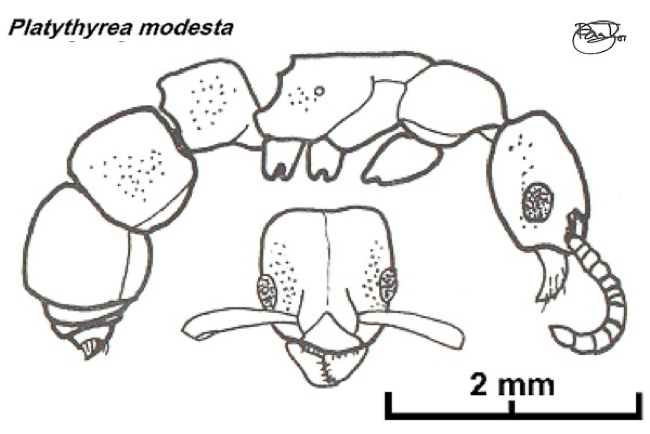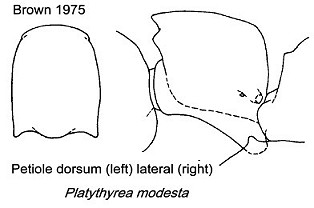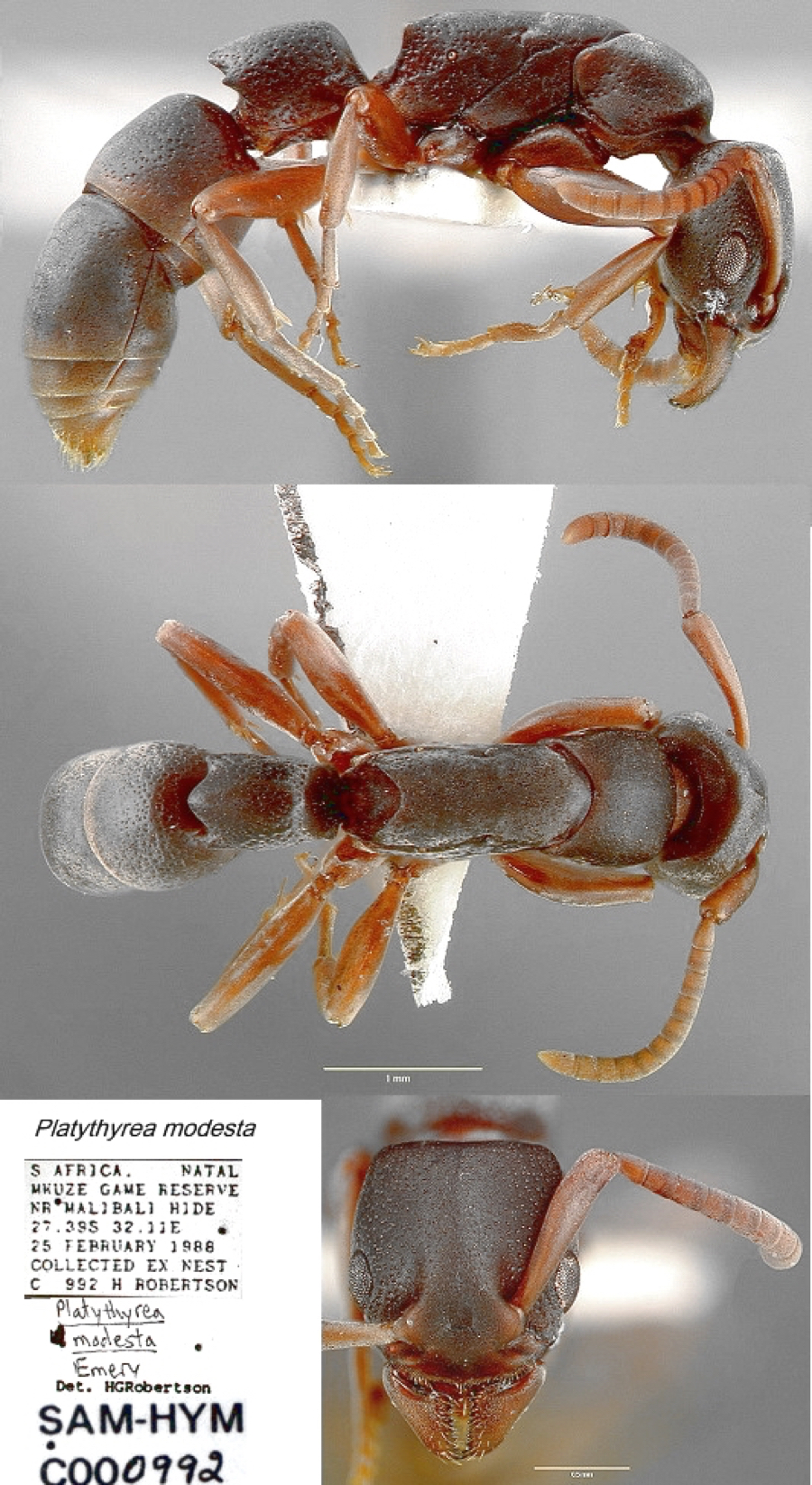Platythyrea modesta Emery
  Type location Cameroun (Platythyrea modesta n. sp., Emery,
1899e: 467, worker) collected at Mundame by Conradt - see below Type location Cameroun (Platythyrea modesta n. sp., Emery,
1899e: 467, worker) collected at Mundame by Conradt - see below
worker and larval
instar described (see Bolton, 1995)  . .
Emery's (1899e) description is at  . .
|
 Nigeria specimens (Taylor, 1976: 9). WORKER. TL
6.6 mm, HL 1.34, HW 1.15, SL 1.03 and PW 0.95. Nigeria specimens (Taylor, 1976: 9). WORKER. TL
6.6 mm, HL 1.34, HW 1.15, SL 1.03 and PW 0.95.
Colour generally black, shiny with grey pubescence, extremities,
red-brown. Eye ovoid with flattened anterior edge. Posterior edge of
propodeum with a pair of small teeth. Posterior edge of petiole with
paired lateral teeth and a single central dorsal tooth.
An uncommon, arboreal species which I recorded twice on cocoa at the
Cocoa Research Institute of Nigera, Idi Ayunre.
Wheeler (1922) noted it also from Equatorial Guinea
and Congo.
|
 Brown (1975: 45) found specimens to be generally somewhat
larger than the specimen he chose as a cotype (syntype) , TL 7.5, HL
1.38, HW 1.14, SL 1.07, from the collection made by Conradt in
Cameroun, 1895. He saw specimens from Kenya (G Allen &
Brooks, Gilgil to Laikipia), Sudan (JG Myers, Khor Aba, Aloma
Plateau), Uganda (Ross & Leech, 10m west of Jinja, 1200m), Zaïre
(Ross & Leech at Thysville and 62 miles east of Kibombo, 14 August
1957); Gabon (Makokou, in rain forest, by I Lieberburg); Ghana
(at Tafo, by B Bolton); and Ivory Coast (ORSTOM, 17 km w of Abidjan, by
himself). The illustration of the petiole (right) is of a specimen
collected near Kimbombo by Ross & Leech. Brown (1975: 45) found specimens to be generally somewhat
larger than the specimen he chose as a cotype (syntype) , TL 7.5, HL
1.38, HW 1.14, SL 1.07, from the collection made by Conradt in
Cameroun, 1895. He saw specimens from Kenya (G Allen &
Brooks, Gilgil to Laikipia), Sudan (JG Myers, Khor Aba, Aloma
Plateau), Uganda (Ross & Leech, 10m west of Jinja, 1200m), Zaïre
(Ross & Leech at Thysville and 62 miles east of Kibombo, 14 August
1957); Gabon (Makokou, in rain forest, by I Lieberburg); Ghana
(at Tafo, by B Bolton); and Ivory Coast (ORSTOM, 17 km w of Abidjan, by
himself). The illustration of the petiole (right) is of a specimen
collected near Kimbombo by Ross & Leech.
Collingwood (1985, illustrated), recording it from Saudi
Arabia, noted that it is an active predator with a relatively sharp
sting; and was collected from an exposed rock in bright sunshine.
|
 The
photomontage of a worker from South Africa is collated from http://www.antweb.org/specimen.do?name=SAM-HYM-C000992b The
photomontage of a worker from South Africa is collated from http://www.antweb.org/specimen.do?name=SAM-HYM-C000992b
Collection Information: Specimen Code SAM-HYM-C000992B; Locality South
Africa: Natal: Mkuze Game Reserve, nr Malibali Hide; 27°39'00"S
032°11'00"E 130 m; Collection codes: SAM-HYM-C000992; Date: 25 Feb
1988; Collected by: H.G.Robertson; Method: breaking open dead
branches/wood; Habitat: woodland: open
Given my specimen from Nigeria and the queen from the
Central African Republic, this is aberrant in terms of colour and
appears to have a small median projection on the clypeus.
|